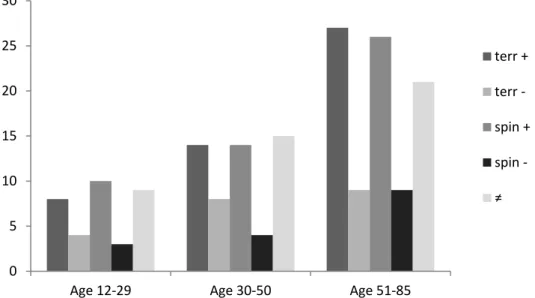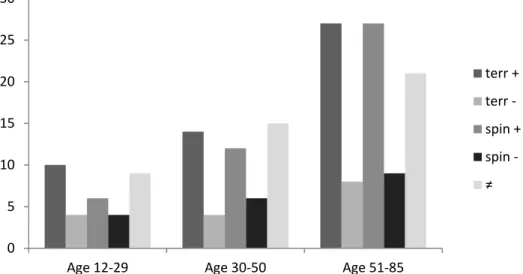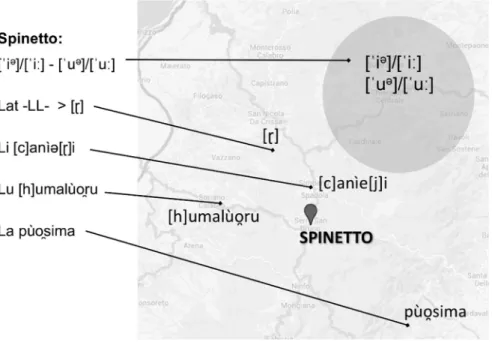Bulletin suisse de linguistique appliquée © 2017 Centre de linguistique appliquée No spécial 2017, 75-89 • ISSN 1023-2044 Université de Neuchâtel
Micro-linguistic differentiation as affirmation
of identity in a southern Italian dialect
Alice IDONE
University of Zurich
University Research Priority Program - Language and Space Freiestrasse 16, 8032 Zürich, Switzerland
alice.idone@uzh.ch
L'article présente un cas de différentiation linguistique due à des dynamiques identitaires au sein d'un petit village du Sud de l'Italie, Serra San Bruno. La thèse de l'existence de deux dialectes différents pour les deux quartiers du village, vivement soutenue par les habitants mais jamais mentionnée dans la littérature, a été expérimentalement testée. Les informateurs ont été appelés à expliciter les éléments de différence ; les réponses ont été vérifiées par rapport aux données de parlé spontané, un questionnaire spécifique et un matched-guise test. L'opposition linguistique a été confirmée, même si ce n'est qu'à un niveau résiduel. La raison du processus de différenciation a été détectée dans le séculaire esprit de clocher qui, de 1783 à presque 1960, a opposé les deux quartiers du village. L'hypothèse la plus plausible est que le quartier de Spinetto, celui de fondation plus récente, a construit son identité en se différenciant au moyen de certaines innovations linguistiques : les modèles pour l'innovation ont été trouvés dans les dialectes limitrophes, mais le plus souvent la communauté de Spinetto a intentionnellement modifié le dialecte Serrese d'origine.
Mots-clés:
Italie méridionale, Calabre, dialectes, conflits sociaux, identité, perception de la diversité.
1. Introduction
In some parts of the world, linguistic diversity is particularly perceptible. This is the case in southern Italy. In this region, the combination of historical, geographic, and social factors has preserved intra- and inter-linguistic variation (see Rohlfs 1966; Radtke 1988; Trumper 1997).
Furthermore, some aspects of the culture of this region, such as a strong parochial spirit, increase the relevance of linguistic variation. The general assumption that each community interprets its own dialect as something unique holds especially true for southern Italy.1
However, a speaker's intuition about his own dialect and those of others might coincide only partially with a linguist's assessment (Preston 1999; Pisoni & Remez 2004).
The present study illustrates a case in which speakers' perception of dialectical difference follows linguistic parameters, and in which the linguistic variation is due to active social processes.
1 Romanello (1999) coined the expression "linguistic chauvinism" to better clarify the attitude of the speakers toward their own dialect.
This research was conducted in Serra San Bruno, a village of 7000 inhabitants in central Calabria (Fig. 1). The village is situated in a mountainous, isolated area. Due to this isolation, the dialect spoken there is highly conservative (see Idone 2012).
Fig. 1: The village of Serra San Bruno in Calabria, Italy.
Upon closer inspection, the urban area is clearly split in two: a tributary of the Ancinale River crosses the small town, creating a border between the two districts of Terravecchia and Spinetto (Fig. 2). It is in these two districts of the same village that, according to the inhabitants of both sides, two different dialects are spoken.
Although the geography of the urban area has contributed to its micro-diatopic variation, this is not the direct cause of the differentiation. Based on official and unofficial written and orally transmitted historical documentation, it is possible to conclude that the rift within the Serrese community originated in, and has been fed by, social reasons.
This paper will present the historical and social conditions that contributed to the onset of the process of differentiation before moving on to the linguistic evidence that allows us to conclude the existence of two different micro-varieties in the local dialect.
Fig. 2: The map of the village of Serra San Bruno. The line marks the border between the two districts. The striped darker area encloses Serra San Bruno at the time of the earthquake (1783).
2. Chronicle of a break up2
In February 1783, a highly damaging earthquake hit a wide area of central Calabria and dramatically changed the destiny of many towns (see Trumper et al. 1995; Vivenzio 1783). For Serra San Bruno this important date also marks the start of the "Serrese secession" and the foundation of the new district of Spinetto.
The two districts are not coeval. Spinetto was built as a recovery area after the earthquake. At that time, fear of the aftershocks, which lasted nearly five months after the earthquake, convinced the inhabitants to leave their unsafe houses in the original settlement (see the striped area in Fig. 2) to seek shelter on the other side of the river. They built a camp there after hacking their way through a thorny thicket.3
In the new area, the inhabitants of Serra San Bruno built some rudimentary huts and a small church. As a sign of devotion, the church was dedicated to the Assumption of the Virgin Mary, like the one they had been forced to leave behind in the village. They retrieved the relics and icons from the almost entirely destroyed old church and moved them to the new one. This would become a crucial part of the story.
2 For the history of Serra San Bruno refer to Andreacchi (2011), Gambino (2005), Pelaia (1982), Principe (1992).
3 This explains the origin of the toponym Spinetto, from Latin *SPINĔCTUM,the 'place where thorns grow'.
In the new area, the inhabitants of Serra San Bruno built some rudimentary huts and a small church. As a sign of devotion, the church was dedicated to the Assumption of the Virgin Mary, like the one they had been forced to leave behind in the village. They retrieved the relics and icons from the almost entirely destroyed old church and moved them to the new one. This would become a crucial part of the story.
As time passed and fear of the earthquake receded, many inhabitants decided to move back to their old houses in the original urban settlement of Terravecchia, namely "the old land", while part of the population decided to remain in the new one.
From that time on, the population remained split. The small river between the two districts became a boundary line.
Conflict eventually flared from issues of parochialism. As a consequence of the separation, Serra San Bruno found itself with two churches dedicated to the Assumption of the Virgin Mary. Which one was to be the church? And most importantly, which one should hold the precious statue of the Virgin Mary? A real dispute began: on the one hand, the inhabitants of Terravecchia claimed ownership of the icon; on the other hand, those of Spinetto refused to move the statue because they believed that this could have disastrous consequences, including potentially a new earthquake.
That was just the beginning of a long period of conflicts, ranging from stealing the clappers of the bells of the opposing side's church, to gunfire on the bank of the river. This tense situation continued until the 1960s.
Of course, this struggle heavily affected the daily life of the inhabitants. Interviews with elderly residents reveal how deep the rift within the community became. Any chance of interaction was strongly and intentionally avoided. Intermarriage between members of the two communities was forbidden. Since there was only one school in the village, lectures were organized in different shifts: the students from Terravecchia attended the school in the morning, while those from Spinetto attended during the afternoon.
A further, non-negligible element of the dispute was fighting over resources. Over the years, access to differing resources influenced the village's social fabric: Terravecchia became more devoted to craftsmanship, while Spinetto lived on agriculture and forest activities, including coal production.
Over nearly two centuries of hostilities, the two districts built their economies, customs, and identities independently of each other.
3. Linguistic traces of old grudges
The inhabitants of the two different areas of the village, who strongly insist that they speak different dialects, appear to have a good historical and social basis for their claim.
However, the significance of social dynamics introduces an important variable to the analysis, which is that the attitude of the speakers may be influenced by their stereotypes about the other group.
In order to determine the validity of the initial hypothesis and to measure the range of variation within the dialects, the following research questions were proposed:
I. To what extent is it possible to affirm the existence of two distinct dialects for the two districts?
II. What parameters constrain the variation?
III. How did the process of linguistic differentiation develop?
The analysis benefited from a combined theoretical and empirical approach: the investigative methods of traditional dialectology were supported by techniques developed in the field of experimental phonetics and folk linguistics.
3.1 Methods
A group of 15 informants was selected from each district according to 3 different age groups: 3 speakers between 12-29, 5 speakers between 30-50, and 7 speakers between 51-85; resulting in a total of 30 speakers from the whole village.
In the first phase, the speakers were asked to explicitly identify the elements of difference in the dialects spoken in the two districts: those who claimed to be aware of the existence of some differences were asked to give examples. The answers were then tested by checking against a spontaneous speech database previously recorded (comprising nearly one hour of recording for each informant) and by means of a further questionnaire submitted at a later time and based on the answers collected in the first phase. Lastly, the degree of awareness of the speakers was tested again by performing a matched-guise test (Stefanowitsch 2005).
3.2 Data
All the informants claimed to be aware of the existence of many differences between Terravecchia and Spinetto's dialects. Of course, as could be expected, explaining and providing concrete examples of the divergences was not as easy a task for them. Nevertheless, despite the variability in the individual answers, the elements of difference detected by the informants pertain, basically, to three main linguistic domains.
The interviewed speakers reported on differences in the lexicon, in how words are pronounced (differences at the phonetic level), and differences pertaining to the prosodic level. The distribution of the answers within the two districts is displayed in Fig. 3.
Fig. 3: The answers given in the two districts sorted according to the linguistic domain of pertinence
The data discussed in the next subsections constitute a synthesis of the answers collected over the different phases of the inquiry. They are the result of a strict selection. The process of selection of the possible variables is illustrated in the chart below (Fig. 4).
Fig. 4: The chart summarizes the process of selection of the answers. In order to be accepted as possible variables, the differences detected by the speakers needed to be attested either in the spontaneous speech or among the replies to the second questionnaire. Failing that, the statements needed to be reported by at least the 60% of the informants.
0 5 10 15 20 25 30 prosody phonetics lexicon Spinetto Terravecchia
3.2.1 Prosody
A significant number of informants (22 speakers out of 30) claimed that one element of divergence is different "calata".
Calata is a Calabrian (and old Italian) word that refers to the manner of speech,
or to a particular inflection and modulation of the voice that may characterize the way of speaking of a region or a narrower area (ex. the calata of Roma, of Milano, etc.) (see Rohlfs 1977; De Mauro 2000). It does not have a definite equivalent in technical terms, but, as its literal meaning of "descent" or "slope" suggests, we can assume that it is more related to the melody of speech than to any other linguistic parameter.
This can be easily inferred based on the words informants used to better clarify what they mean by "different calata" (1).
(1) TER_CU: "they (those of Spinetto) talk in a ruder way" TER_VS: "they speak with a closed and tight mouth" SPI_SG: "They have a slower rhythm"
SPI_MZ: "They jump with the voice while talking"
In light of statements like these, the cross-speaker variability of the melodic contour was investigated using a prosodic test that included declarative, interrogative, imperative, and exclamatory sentences. Possible differences related to rhythm have been verified as well.
Acoustic analysis confirmed the initial auditory impression: there are no significant differences in the prosody or in the rhythm of the two varieties. The prosodic test showed the same distribution for prominence. Pitch contours match.4
3.2.2 Phonetics
Turning to the phonetic level, 60% of the informants suggested a different pronunciation for retroflex consonants (2):
(2) TER_CU: "we say [kaˈvaːɖʊ], they say [kaˈvaːdʒʊ] … [kaˈvaːjʊ], I don't know how to explain"
SPI_BT: "we pronounce [ˈʂɽaːta], [ˈkɔːɽu], [ˈkɪːɽʊ] with closed mouth"
The range of variation in the production of retroflex consonants detected by the informants turned out to be true, but only for the outcomes of Lat. -LL-.5 In words
like i[ɖ]u (< Lat. ĬLLU) 'he/him'; cava[ɖ]u (< *CABALLU) 'horse', the Terravecchia
variety has the voiced dental retroflex [ɖ] (the expected outcome, see Bianco 1981), whereas in Spinetto that outcome incurred in rhotacization ([ɖ] > [ɽ]).
4 For an extensive exemplification see Idone (2012).
5 For a detailed description of the distribution of retroflex consonants in the Serrese dialect see Idone (2012).
The other phonetic differences detected by the informants did not emerge as significant in the analysis. Among these, the [ʃ] vs. [ç] opposition for the outcomes of the Lat. FL- (ex. [ˈçʊːmɪ] < Lat. FLUMEN 'river'). In both varieties [ç]
is the only attested phone.
Comparison of the two databases of spontaneous speech revealed a phonetic difference that was not mentioned during the interviews: the differing realization of metaphonetic diphthongs. The speakers of Spinetto tend to concentrate the articulatory force on the first element of the diphthong. Thus, it causes the diphthongs [ˈɪɛ̯] and [ˈʊɔ̯] to be generally realized as [ˈɪə] and [ˈʊə]; or, in some cases, to reach monophthongization (Fig. 5).6
Fig. 5: In a) the spectrograms of the word [ʧʊtʧaˈrɪɛ̯ɖʊ] 'little donkey’ pronounced by the informant TER_CU from Terravecchia; in b) the same word pronounced by the informant SPI_SG from Spinetto. In spectrogram b) there is no diphthong: [ʧʊtʧaˈrɪːɽʊ].
3.2.3 Lexicon
More than in structural elements or in real sociophonetic markers, the linguistic differentiation between Terravecchia and Spinetto currently exists in a list of seven words (Fig. 6) systematically elicited (and correctly attributed in the matched-guise test, see par 3.3) from all the informants.
6 This characteristic could give a possible explanation to the statements reported in (1) (par. 3.2.1) about the different prosody. Judgements like "slower rhythm" or "jumps in the speech" could be related to the different realization of the diphthongs.
Terravecchia Spinetto
[1] La patata Lu patatu The potato [2] Lu [h]umìe̯ri Lu [ç]umìəri The manure
[3] La posa di lu ca[h]è La pùo̯sima Coffee grounds [4] Li [ʂʈɽ]a[h]uli Li [c]anìə[ɽ]i The slippers [5] Lu [ç]umi La [ç]umara The river [6] Lu bbraccuni Lu barcuni The balcony [7] Lu [h]umularu Lu [h]umalùo̯ru The chimney
Fig. 6: List of the words that differ in the two varieties.
The linguistic variation operates in several ways. In the first example [1], the difference is in the gender of the term, which is feminine in Terravecchia's dialect but masculine in Spinetto's (patata vs. patatu). In [6], bbraccuni is clearly a metathesis of barcuni. In [2] only the phonetic level is involved.7 In puosima
vs. posa di lu cahè [3] the difference lies in the different etymology of the lexemes, Greek in the first case and Latin in the second. Sʈɽahuli and chjanieɽi [4], instead, are different lexical entries.8 Examples [5] and [7] are the result of
the selection of different derivative suffixes.
3.3 The matched-guise test
The mismatch between the level of perceived variation and the effective range of variation revealed by the preliminary results (see par. 3.2.1 and 3.2.2) made it necessary to conduct a matched-guise test (Lambert et al. 1960; Stefanowitsch 2005).
The task the informants were asked to perform was to judge whether the sentences were pronounced by a speaker from Spinetto, Terravecchia, or a different village.
The trial set was composed of the following stimuli:
• 4 sentences from Terravecchia with a verified element of difference (TERR+);
• 4 sentences from Terravecchia with no significant elements of difference (TERR-);
• 4 sentences from Spinetto with a verified element of difference (SPIN+);
7 The [h] vs. [ç] opposition pertains only to this case; it is not systematic.
8 The one attested in Spinetto is the most common among Calabrian dialects (see Rohlfs 1977); that of Terravecchia has probably an onomatopoeic origin, since it has no clear etymon and the initial [sʈɽa] seems to imitate the sound of slippers crawling.
• 4 sentences from Spinetto with no significant differences (SPIN-); • 3 sentences coming from different dialects (≠);
The auditory stimuli were extracted from the corpus of spontaneous speech and from the answers to the second questionnaire.
For the purpose of the test, which was to verify any correlation between stated and perceived difference, the same sample of informants was kept. The environment of the test demanded a slight manipulation of the acoustic stimuli. This avoided the possibility that, in such a small community, attribution of the sample to one or the other variety could have been determined by recognizing the voice (and therefore the provenience) of the speaker rather than by relevant linguistic features.9
The "different village" stimuli set consists of sentences from the dialects of Villa San Giovanni and Bivongi.10
The results are illustrated in Fig. 7 and in Fig. 8.
Fig. 7: The results of the matched-guise test for the district of Spinetto.
The elder informants of both districts gave the greatest number of correct answers, while the judgment of the remaining groups (including speakers from
9 The disguise procedure consisted, basically, in the manipulation of the formant shift ratio, the pitch median, the pitch range, and the duration of the acoustic signal. To achieve this, the Praat Software (http://www.fon.hum.uva.nl/praat) was used. The naturalness of the voice was preserved. In order to double check whether the voices were recognisable or not, the matched-guise test was preceded by a trial session: given the same stimuli set, the informants were asked to try to recognise to whom the recorded voices belonged. Only in one case one of the participants gave a correct answer.
10 The recordings are from personal fieldwork. The selection of those dialects has a precise motivation: they are both southern Calabrian dialects, but the one of Bivongi is more similar to that of Terravecchia and Spinetto if compared to the one of Villa San Giovanni.
0 5 10 15 20 25 30
Age 12-29 Age 30-50 Age 51-85
terr + terr -spin + spin -≠
12 to 50 years) can not be considered significant. Considering this finding, the most unexpected result of this test is the fact that informants from the 30-50 age group are those who are most insistent about the existence of two distinct dialects.
Fig. 8: The results of the matched-guise test for the district of Terravecchia.
4. Results and discussion
The data presented so far provides answers to two of the three research questions (see par. 3). Only a small part of the differences detected by the informants turned out to be significant. This result is fully in accordance with the principles of perceptual dialectology (see Montgomery & Beal 2011; Rensink 1999). The inaccurate judgement is not only a predictable factor, it is also clear evidence of the relevance of social and psychological aspects in metalinguistic tasks.
As the results of the matched-guise test show (see Fig. 7 and Fig. 8), only the elder informants are fully aware of the range of variation between the two varieties. And yet, middle-aged speakers are the ones who argue more insistently that the two dialects are different. Their perception about "a different way of speaking" is indeed true, but features like the different pronunciation of diphthongs or of retroflex consonants (see par. 3.2.2) represent real sociolinguistic markers (see Krauss & Pardo 2005 for the definition) only for the previous generation; younger informants are able to distinguish clearly between the two varieties only when one of the words listed in Fig. 6 (par. 3.2.3) is present. New generations are perpetuating the myth of a linguistic contraposition as a folkloric symbol.
Regarding the existence of two different dialects in the two districts of Serra San Bruno, we must conclude that no such dialectical difference exists. Whichever definition of dialect is applied, the attested range of variation is neither
0 5 10 15 20 25 30
Age 12-29 Age 30-50 Age 51-85
terr + terr -spin + spin -≠
sufficiently wide or significant enough to speak of two dialects. However, it is possible to state that two micro-varieties of the dialect of Serra San Bruno do exist.
Further unanswered questions concern the development of the process of micro-linguistic differentiation. What was the trigger for the change? In which district did it originate?
Different hypotheses have been considered and tested:
I. the influence of a specific neighbor dialect on one of the two varieties; II. the conservation of two different chronological stages;
III. an independent innovation started from one of the two varieties.
The first hypothesis is rejected, as there is no compelling evidence, neither historical nor linguistic, to support this reconstruction.
Geo-linguistic comparison contradicts the chronological hypothesis as well. It would not be correct to state that the two micro-varieties represent two different stages of the same linguistic change. The case of retroflexation (par. 3.2.2) can serve as an example: the outcome for Lat. -LL-is [ɖ] in Terravecchia and [ɽ] in
Spinetto. If the variety of Spinetto was the diachronic evolution of that of Terravecchia, we would expect [ɖ] to become [d], as occurred in many other dialects within the same area, not a more marked phone like [ɽ].
In this context, the hypothesis of independent innovation is the most plausible. Geo-linguistic comparison still provides useful fundamental information, especially to trace sources of the changes. Surveys carried out in the surrounding villages show that most of the linguistic features peculiar to Spinetto are attested in different parts of the surrounding area.11
The thesis defended here is that Spinetto is the innovative variety: given the framework in Fig. 9, it is more plausible to suppose that Terravecchia preserves the features of the autochthonous dialect of Serra San Bruno, features that the district of Spinetto has voluntarily abandoned.
The data discussed so far corroborate the hypothesis that the district of Spinetto, founded more recently, has built its linguistic identity by differentiating itself using innovations.
As is well known, ethnolinguistic identity issues play a very important role for those groups existing in the shadow of an overbearing neighbor. Terravecchia had its own history and identity which Spinetto lacked. Linguistic innovation became a strategy to develop that identity. In some cases, Spinetto found the models for the innovation in neighboring dialects. There is, however, no
11 Most of the data come from personal fieldworks. For the phenomenon of monophthongization in Calabrian dialects see also Romito & Gagliardi (2009).
evidence for the influence of one specific dialect. More often, the linguistic community in Spinetto intentionally modified the Serrese dialect with superficial modifications, like the change in the grammatical gender of 'potato', or the selection of different derivative suffixes (see Fig. 6).
Fig. 9: The main features of Spinetto (on the left) and the same linguistic types in the surrounding area.
5. Conclusion
We have investigated the claim of the existence of two different dialects in the districts of Serra San Bruno.
The speakers' perception of the linguistic distance between the two varieties was central to the design of the experimental set. These self-reported perceptions contributed to the description of a complex linguistic framework. The data, gathered in different phases using different methods, confirm the existence of a range of variation in the language within the village. Nevertheless, the variance attested is not significant enough to prove the existence of two different dialects. From the synchronic point of view, the spoken language in Terravecchia and in Spinetto are two micro-varieties of the dialect of Serra San Bruno. From a diachronic perspective, the evidence suggests that the variety spoken in Spinetto is the result of voluntary innovation by the residents of that district, while that of Terravecchia represents the autochthonous way of speaking.
The historical motivation behind this innovation rests in the centuries-old parochialism that, from 1783 until almost the 1960s, divided the village's two districts.
The data lead us to conclude that the trigger for the linguistic change was the will of the community of Spinetto to affirm its own identity and to distinguish itself from Terravecchia.
Today, the opposition between the two varieties must be considered residual. At this point, it is impossible to determine whether or not the linguistic gap was wider in the past. Based on the behaviour of younger informants in the ages 12 to 30, the most plausible prediction is that the range of variation will decrease over time. Lacking the root cause, social conflict, no longer a priority for the two communities to affirm their identity through language.
REFERENCES
Andreacchi, R. (2011). San Bruno, da Colonia alla Certosa. L'uomo che percorse l'Europa. Squillace: Grafiche Falcone.
Bianco, E. (1981). Gli sviluppi di ll in Calabria. La ricerca dialettale, 121-137. De Mauro, T. (2000). Grande dizionario italiano dell'uso. Torino: UTET. Gambino, S. (2005). Sull'Ancinale, Serra San Bruno: Edizioni Il Brigante.
Idone, A. (2012). Il dialetto di Serra San Bruno. Descrizione e analisi di alcuni aspetti fonologici e morfologici. University of Pisa: unedited thesis.
Krauss, R.M. & Pardo, J.S. (2005). Speaker perception and social behaviour. Bridging social psychology and speech science. In P.A.M. van Lange (ed.), Bridging social psychology: benefits of transdisciplinary approaches. Mahwah: Erlbaum.
Lambert, W. E., Hodgson, R. C. Gardner, R. C., Fillenbaum, S. (1960). Evaluational Reactions to Spoken Languages. Journal of Abnormal and Social Psychology, 20(1), 44-51.
Montgomery, C. & Beal, J. (2011). "Perceptual Dialectology". In W. Maguire & A. McMahon (eds.), Analysing Variation in English (pp. 121-148). Cambridge, NY: Cambridge University Press.
Pelaia, B. (1982). Li stuori. Serra San Bruno: Tipografia Mele.
Pisoni, D. B. & Remez, R. E. (2004). The Handbook of Speech Perception. Oxford: Blackwell Publishing. Preston, D. R. (1999). Handbook of perceptual Dialectology, Amsterdam: John Benjamins.
Principe, I. (1992). San Bruno e la Calabria: alle origini della fondazione certosina a Santa Maria del Bosco. Lamezia Terme: La Modernissima.
Radtke, E. (1988). Kalabrien. In G. Holtus, M. Metzeltin & C. Schmitt (eds.), Lexikon der Romanistischen Linguistik (LRL). Band/Volume IV. Italienisch, Korsisch, Sardisch (pp. 661-668). Tübingen: Niemeyer.
Rensink, W.G. (1999). Informant classification of dialects. In D. R. Preston (ed.), Handbook of Perceptual Dialectology (1 ed.) (pp. 3-7). Amsterdam: John Benjamins.
Rohlfs, G. (1966). Grammatica storica della lingua italiana e dei suoi dialetti, Fonetica, vol 1. Torino: Einaudi.
Rohlfs, G. (1977). Nuovo dizionario dialettale della Calabria. Ravenna: Longo.
Romanello, M. T. (1999). The perception of urban varieties: Preliminary strudies from the south of Italy. In D. R. Preston (ed.), Handbook of perceptual Dialectology (pp. 331-350). Amsterdam: John Benjamins.
Romito, L. & Gagliardi, D. (2009), La metafonia in alcuni centri del nord Calabria: verso una mappa regionale. In L. Romito, D. Gagliardi, V. Galatà & R. Lio (eds), La fonetica sperimentale: metodo
e applicazioni. Atti del IV convegno nazionale dell'Associazione Italiana di Scienze della Voce (Università della Calabria, 3-5 dicembre 2007) (pp. 423-437). Torriana: EDK.
Stefanowitsch, A. (2005). Empirical methods in linguistics: The matched guise Technique. <http://www1.unihamburg.de/stefanowitsch/docs/exp_matchedguise.pdf>.
Trumper, J. (1997). Calabria and Southern Basilicata. In M. Maiden & M. Parry (eds.) The Dialects of Italy (pp. 355-364), London: Routledge.
Trumper, J.B., Maddalon, M. & Chiodo, G. (1995). L'influenza di eventi macrosismici su alcune discontinuità linguistiche (Calabria). In G.B. Pellegrini (ed.), Saggi dialettologici in area italoromanza (pp. 89-105). Roma: CNR.
Vivenzio, G. (1783). Istoria e teoria de' tremuoti in generale ed in particolare di quelli della Calabria, e di Messina del MDCCLXXXIII (pp. 201-210). Napoli: Stamperia Regale.
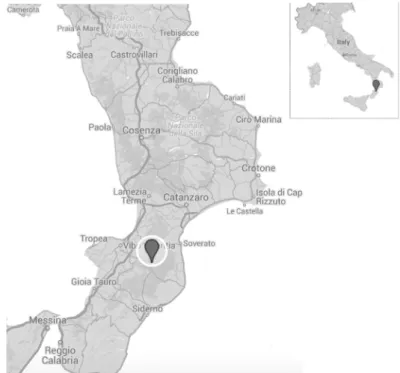
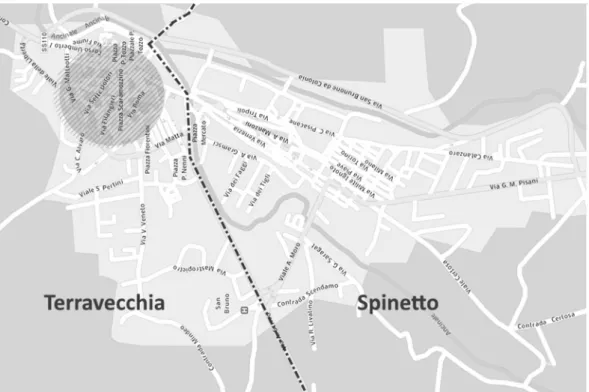
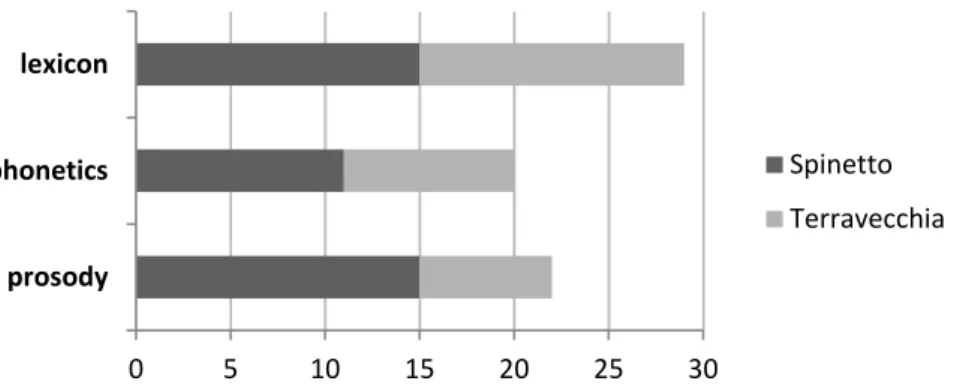
![Fig. 5: In a) the spectrograms of the word [ʧʊtʧaˈrɪɛ̯ɖʊ] 'little donkey’ pronounced by the informant TER_CU from Terravecchia; in b) the same word pronounced by the informant SPI_SG from Spinetto](https://thumb-eu.123doks.com/thumbv2/123doknet/14936857.665950/8.892.167.699.401.749/spectrograms-ʧʊtʧaˈrɪɛ-pronounced-informant-terravecchia-pronounced-informant-spinetto.webp)
